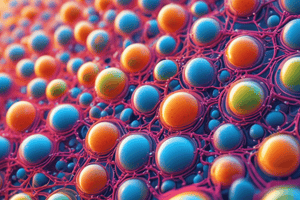Podcast
Questions and Answers
What is the primary function of the sodium-potassium pump in cellular transport?
What is the primary function of the sodium-potassium pump in cellular transport?
- Facilitate the passive diffusion of sodium ions
- Create membrane potential by inactivating potassium ions
- Transport glucose into the cell
- Maintain ion gradients using ATP energy (correct)
How many sodium ions are transported out of the cell for each ATP hydrolyzed by the sodium-potassium pump?
How many sodium ions are transported out of the cell for each ATP hydrolyzed by the sodium-potassium pump?
- Four sodium ions
- Two sodium ions
- Five sodium ions
- Three sodium ions (correct)
In which way does the sodium-potassium pump affect the electrical gradient across the membrane?
In which way does the sodium-potassium pump affect the electrical gradient across the membrane?
- It decreases the electrical gradient by allowing ions to flow freely
- It has no effect on the electrical gradient
- It stabilizes the electrical gradient through equal transport of sodium and potassium
- It increases the electrical gradient by transporting more potassium than sodium (correct)
What role does the sodium ion gradient created by the sodium-potassium pump play in intestinal epithelial cells?
What role does the sodium ion gradient created by the sodium-potassium pump play in intestinal epithelial cells?
What process occurs after sodium ions are released outside the cell by the sodium-potassium pump?
What process occurs after sodium ions are released outside the cell by the sodium-potassium pump?
What is the primary reason the sodium-potassium pump is crucial for maintaining ion gradients?
What is the primary reason the sodium-potassium pump is crucial for maintaining ion gradients?
Which of the following describes the transport mechanism of the sodium-potassium pump?
Which of the following describes the transport mechanism of the sodium-potassium pump?
How does the sodium gradient created by the sodium-potassium pump assist in glucose transport in the small intestine?
How does the sodium gradient created by the sodium-potassium pump assist in glucose transport in the small intestine?
What effect does the sodium-potassium pump have on the resting membrane potential of a cell?
What effect does the sodium-potassium pump have on the resting membrane potential of a cell?
What happens to the affinity of the sodium-potassium pump for sodium ions during the transport process?
What happens to the affinity of the sodium-potassium pump for sodium ions during the transport process?
What is the net transport of ions by the sodium-potassium pump per ATP hydrolyzed?
What is the net transport of ions by the sodium-potassium pump per ATP hydrolyzed?
What physiological role does the sodium-potassium pump serve in most animal cells?
What physiological role does the sodium-potassium pump serve in most animal cells?
What occurs immediately after potassium ions bind to the sodium-potassium pump?
What occurs immediately after potassium ions bind to the sodium-potassium pump?
Which statement best describes the relationship between concentration gradient and electrochemical gradient for a solute?
Which statement best describes the relationship between concentration gradient and electrochemical gradient for a solute?
What physiological condition occurs when the sodium-potassium pump is inhibited?
What physiological condition occurs when the sodium-potassium pump is inhibited?
Flashcards are hidden until you start studying
Study Notes
Electrochemical Gradient
- Electrochemical gradients determine solute transport via concentration gradients and electrical potential differences.
- Membrane potential arises from differences in electrical charge across the membrane.
Sodium-Potassium Pump
- Ion pumps, such as the sodium-potassium pump, create and maintain ion gradients using ATP hydrolysis.
- The pump actively transports three sodium ions out of the cell and two potassium ions into the cell for each ATP molecule hydrolyzed.
- High affinity for sodium ions within the cell leads to binding; ATP phosphorylation alters pump conformation, reducing sodium affinity, resulting in sodium release outside the cell.
- Potassium ions bind outside the pump, leading to dephosphorylation and conformational changes, allowing potassium ions to enter the cell.
Functions and Significance
- The sodium-potassium pump establishes concentration and electrical gradients vital for cellular functions.
- It is prevalent in most animal cells, influencing a significant portion of the basal metabolic rate.
- In the small intestine, the sodium gradient generated by the pump facilitates glucose transport.
Glucose Transport
- The glucose transporter utilizes the sodium gradient established by the sodium-potassium pump for active transport of glucose.
- Sodium ions enter intestinal epithelial cells down their concentration gradient while glucose is simultaneously transported against its own concentration gradient through the glucose symport mechanism.
Electrochemical Gradient
- Electrochemical gradients determine solute transport via concentration gradients and electrical potential differences.
- Membrane potential arises from differences in electrical charge across the membrane.
Sodium-Potassium Pump
- Ion pumps, such as the sodium-potassium pump, create and maintain ion gradients using ATP hydrolysis.
- The pump actively transports three sodium ions out of the cell and two potassium ions into the cell for each ATP molecule hydrolyzed.
- High affinity for sodium ions within the cell leads to binding; ATP phosphorylation alters pump conformation, reducing sodium affinity, resulting in sodium release outside the cell.
- Potassium ions bind outside the pump, leading to dephosphorylation and conformational changes, allowing potassium ions to enter the cell.
Functions and Significance
- The sodium-potassium pump establishes concentration and electrical gradients vital for cellular functions.
- It is prevalent in most animal cells, influencing a significant portion of the basal metabolic rate.
- In the small intestine, the sodium gradient generated by the pump facilitates glucose transport.
Glucose Transport
- The glucose transporter utilizes the sodium gradient established by the sodium-potassium pump for active transport of glucose.
- Sodium ions enter intestinal epithelial cells down their concentration gradient while glucose is simultaneously transported against its own concentration gradient through the glucose symport mechanism.
Studying That Suits You
Use AI to generate personalized quizzes and flashcards to suit your learning preferences.



